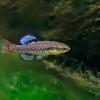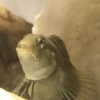Hi everyone! I was thinking of setting up a 54 inch by 36 inch by 20H inch water trough as a water garden next year and was wondering what to put in it. My thoughts have wandered to mudminnows...not very colorful, but they would have a LONG season in my water garden and might even spawn if I put them out early enough. How would mudminnows do in a water garden? Would they survive under a thin layer of ice in a container pond? And could I house them in a 10 gallon when it gets so cold even the mudminnows need to come in? Thanks ![]()

Mudminnows in a container pond
#1

Posted 11 September 2018 - 08:15 AM
#2

Posted 11 September 2018 - 12:12 PM
Yes - IMO they are the all-around best fish for small pools and tubs (provided that you're OK with never seeing them). Better freeze-tolerance than Gambusia, good heat tolerance, and great skeeter-eaters. I've had a colony for years in a 12" deep wading pool above ground in central NC. It gets 2-3" thick ice in winter. Fry appear most years in early April. They're the only fish I've had overwinter in above-ground containers reliably year after year.
Gerald Pottern
-----------------------
Hangin' on the Neuse
"Taxonomy is the diaper used to organize the mess of evolution into discrete packages" - M.Sandel
#5

Posted 24 June 2023 - 06:04 PM
I’m going to echo what gerald posted. They are hardy fish and should do well. Zone 5 is a bit on the cold side, but unless it freezes to the bottom, I’m sure they would do well.
I have 4 adults in a 300 gallon tank currently that is well-planted with lots of hiding spaces, but they will come out for worms I feed them day or night (flashlight) so you can still enjoy seeing them. Their feeding behavior is fun to watch!
Edited by Pike, 24 June 2023 - 06:07 PM.
#6

Posted 28 June 2023 - 03:29 PM
I know that a lot of these threads are old, but, Pike, I'm interested collectively in your posts, in particular about the mudminnows. I've never caught or kept them, but hope to in the near future. I'm curious, if you or anyone else knows, are mudminnows cannibalistic?
Thanks.
Kevin Wilson
#7

Posted 28 June 2023 - 10:19 PM
I know that a lot of these threads are old, but, Pike, I'm interested collectively in your posts, in particular about the mudminnows. I've never caught or kept them, but hope to in the near future. I'm curious, if you or anyone else knows, are mudminnows cannibalistic?
Thanks.
Good question. I don’t know. If you search here and elsewhere, people have fed guppies to them and they do have small fish listed in their diet. My sense is they do not prefer fish over crustaceans and worms, but I am getting the sense that it is related to the way they feed. They, like pickerel and pike, target movement and prefer to eat moving prey, as opposed to, say, catfish, that target based on smell/taste. I think that even the sinking action of frozen, dead bloodworms is enough to get Mudminnows to strike. I keep Chain pickerel that are ridiculously abundant here and they will only eat moving food, but a dead sinking minnow will trigger a strike.
I’ve been slowly moving the larva/fry I currently have in the 300 gallon tank with the adults into separate tanks. The larva/fry lie very still near the surface, mid and lower part of the water column and I think the lack of movement makes it less likely for the adults to feed on them. I’m mainly concerned about cannibalism which is why I’m making the move, but it’s also to keep better visuals on them to make sure they are feeding well. I have not seen the adults targeting the fry, and I have make a huge effort to keep the adults extremely well-fed with earthworm. The less hungry they are, the less I have to worry about them eating the babies! That’s the theory anyway. I’ve moved about 35 fry out of the 300 gallon tank. I initially thought that the Central Mudminnow fry were Largemouth Bass fry that had hitched a ride on aquatic plants! So I initially didn’t move any of them to a separate tank.
My advice is to try to separate the Central Mudminnows by size up to the point that the smaller ones can’t be eaten by the larger ones just to be on the safe side. I am still moving mine but it’s a slow process as I work full-time and I can only spot and catch them easily with a small net and flashlight at night.
This is a video of me feeding the adults earthworms if you haven’t seen it already:
https://www.youtube....h?v=HNg7blUXCZU
I plan on making many more videos. I’d like to dedicate at least a few to the Daphnia I’m raising to feed the Mudminnow fry. I have raised Daphnia for years both indoors and outdoors for fun but also with the idea that I could use them to feed fish. I raise Moina, Daphnia pulex, and Daphnia magna.
Edited by Pike, 28 June 2023 - 10:23 PM.
#13

Posted 03 July 2023 - 09:39 AM
Mike, I read the article. Very informative stuff! I found it interesting that Central Mudminnows likely spawn earlier than what I’ve read (water temperatures of 50 to 59F):
Another winter, during a pre-spring thaw, cabin fever got the best of my wife and I so we went to hike a nearby trail that ran between a still frozen swamp and a canal. As we walked I noticed the very edge of the ice on the swamp was melted or very thin. If only I had a net! Of course I had a net, carefully packed in my backpack next to the breather bags and thermos of hot chocolate. A couple kicks and the ice opened enough to dip my 10-inch aquarium net into the water and drag it back through the half rotted vegetation, leaves and plant roots. After pulling out shards of ice and debris, much to my surprise, I noticed a few still active water bugs which upon closer inspection turned out to be tiny barely quarter inch baby Central Mudminnows. Apparently spring wasn’t only just in the air but in the mudminnow water as well.
I kept the 4 larger adults in my freezing garage with the top of the 50 gallon plastic barrel freezing up to 1/4 to 1/2”. They were fed worms all winter and ate all winter regardless of water temperature. I only put them outside when the water was in the low 40’sF, figuring that would be well before they would spawn. I’m lucky they didn’t spawn in the garage! I had set up the outdoor 300 gallon stock tank so I had a thriving Daphnia pulex and Cyclops community for any newborn larval Central Mudminnows to eat which I would not have had in the garage! It worked out perfectly as the adult Mudminnows simply were too big to even bother with that smaller Daphnia species which is why I picked them over the Daphia magna. I will be posting more about this.
Edited by Pike, 03 July 2023 - 09:41 AM.
#15

Posted 12 July 2023 - 08:48 AM
PS- all those killies in that creek are now replaced with gambusi.
#16

Posted 14 July 2023 - 09:13 PM
When I was a kid. We would throw the killie trap in the creek and the water would churn and it would be full of banded killie fish. Once just one I got something else. It stood out and I brought it home. I had no idea what it was and the internet wasnt even a thing, yet. It wasnt till I was an adult that I found out it was a eastern mud minnow. Very cool fish for the aquarium. I can still picture its globe like eyes.
PS- all those killies in that creek are now replaced with gambusi.
I just read about them:
“The native range of the mosquitofish is from southern parts of Illinois and Indiana, throughout the Mississippi River and its tributary waters, to as far south as the Gulf Coast in the northeastern parts of Mexico.[21] They are found most abundantly in shallow water protected from larger fish.[11] Mosquitofish can survive relatively inhospitable environments, and are resilient to low oxygen concentrations, high salt concentrations (up to twice that of sea water), and temperatures up to 42 °C (108 °F) for short periods.[14]Because of their notable adaptability to harsh conditions and their global introduction into many habitats for mosquito control, they have been described as the most widespread freshwater fish in the world.[22] Some of their natural predators include the bass, catfish and bluegill.”
Isn’t malaria making a resurgence in Texas and Florida? We may need more gambusi!
I grew up in Canada along the St-Lawrence River and we had a ton of Banded Killifish. They loved hanging out in large shoals in the shallow, sandy-bottomed waters off islands.
Reply to this topic
1 user(s) are reading this topic
0 members, 1 guests, 0 anonymous users










